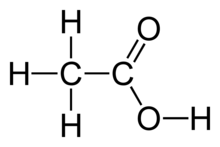Acetic acid (medical use)
Acetic acid, which at low concentrations is known as vinegar, is an acid used to treat a number of conditions.
 Chemical formula of acetic acid | |
| Clinical data | |
|---|---|
| Pronunciation | a-SEE-tik |
| Trade names | Acetasol, Vasotate, Acid Jelly, Domeboro Otic, others |
| Other names | Vinegar |
| AHFS/Drugs.com | Monograph |
| License data |
|
| Routes of administration | ear drops |
| ATC code | |
| Legal status | |
| Legal status |
|
| Identifiers | |
| CAS Number | |
| PubChem CID | |
| DrugBank | |
| ChemSpider | |
| UNII | |
| Chemical and physical data | |
| Formula | C2H4O2 |
| Molar mass | 60.052 |
| 3D model (JSmol) | |
| |
| |
Definition and medical uses
As an eardrop it is used to treat infections of the ear canal.[1] It may be used with an ear wick.[2] As a liquid it is used to flush the bladder in those who have a urinary catheter in an attempt to prevent infection or blockage.[3] As a gel it may be used to adjust the pH of the vagina.[4] It may also be applied to the cervix to help detect cervical cancer during screening.[5]
Side effects may include burning at the site of application.[6] Allergic reactions may rarely occur.[6] Use is not recommended in the ear in people who have a hole in the eardrum.[7] It works against both bacterial and fungal causes of external ear infections.[7]
History and culture
Acetic acid has been used medically since the time of Ancient Egypt.[8][9] It is on the World Health Organization's List of Essential Medicines, the safest and most effective medicines needed in a health system.[10] Acetic acid is available as a generic medication.[2] In the United States a course of treatment with the ear preparation costs less than US$25.[2] Acetic acid is more commonly used for external ear infections in the developing world than the developed.[11]
Medical uses
Acetic acid may be applied to the cervix to help detect cervical cancer during screening in many areas in the developing world.[5] Acetic acid is applied to the cervix and if an area of white appears after about a minute the test is positive.[5]
References
- "Acetic acid (otic) medical facts from Drugs.com". www.drugs.com. Archived from the original on 18 January 2017. Retrieved 14 January 2017.
- Hamilton, Richart (2015). Tarascon Pocket Pharmacopoeia 2015 Deluxe Lab-Coat Edition. Jones & Bartlett Learning. p. 252. ISBN 9781284057560.
- "Acetic Acid". The American Society of Health-System Pharmacists. Archived from the original on 18 January 2017. Retrieved 8 January 2017.
- "Acetic acid gel: Indications, Side Effects, Warnings - Drugs.com". www.drugs.com. Archived from the original on 18 January 2017. Retrieved 14 January 2017.
- Fokom-Domgue, J; Combescure, C; Fokom-Defo, V; Tebeu, PM; Vassilakos, P; Kengne, AP; Petignat, P (3 July 2015). "Performance of alternative strategies for primary cervical cancer screening in sub-Saharan Africa: systematic review and meta-analysis of diagnostic test accuracy studies". BMJ (Clinical research ed.). 351: h3084. doi:10.1136/bmj.h3084. PMC 4490835. PMID 26142020.
- "Acetic acid otic Side Effects in Detail - Drugs.com". www.drugs.com. Archived from the original on 18 January 2017. Retrieved 14 January 2017.
- "Acetic Acid - FDA prescribing information, side effects and uses". www.drugs.com. Archived from the original on 18 January 2017. Retrieved 14 January 2017.
- Cook, Larry (2005). The Beginner's Guide to Natural Living: How to Cultivate a More Natural Lifestyle to Lose Weight, Prevent Degenerative Disease, Improve Your Energy and Attain Vibrant Health. EcoVision Communications. p. 107. ISBN 9780975536186. Archived from the original on 16 January 2017.
- Cumston, C. G. (2013). The History of Medicine. Routledge. p. Chapter 2. ISBN 9781136194252. Archived from the original on 16 January 2017.
- World Health Organization (2019). World Health Organization model list of essential medicines: 21st list 2019. Geneva. hdl:10665/325771. WHO/MVP/EMP/IAU/2019.06. License: CC BY-NC-SA 3.0 IGO.
- Desai, Bobby; Desai, Alpa (2016). Primary Care for Emergency Physicians. Springer. p. 36. ISBN 9783319443607. Archived from the original on 16 January 2017.
External links
- "Acetic acid". Drug Information Portal. U.S. National Library of Medicine.